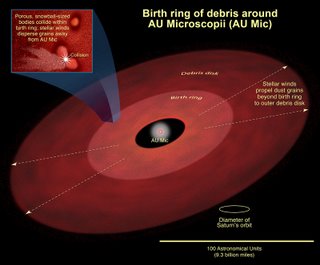Space Dust

_______________________________________________________
Eagle Nebula "Pillars of Creation" Credit: nasa spitzer
Famous Space Pillars Feel The Heat Of Star's Explosion
A new, striking image from Spitzer shows the intact dust towers next to a giant cloud of hot dust thought to have been scorched by the blast of a star that exploded, or went supernova.
Astronomers speculate that the supernova's shock wave could have already reached the dusty towers, causing them to topple about 6,000 years ago. However, because light from this region takes 7,000 years to reach Earth, we won't be able to capture photos of the destruction for another 1,000 years or so.
Spitzer's view of the region shows the entire Eagle nebula, a vast and stormy community of stars set amid clouds and steep pillars made of gas and dust, including the three well-known "Pillars of Creation."
Astronomers have long predicted that a supernova blast wave would mean the end for the popular pillars. The region is littered with 20 or so stars ripe for exploding, so it was only a matter of time, they reasoned, before one would blow up. The new Spitzer observations suggest one of these stellar time bombs has in fact already detonated, an event humans most likely witnessed 1,000 to 2,000 years ago as an unusually bright star in the sky.
Whenever the mighty pillars do crumble, gas and dust will be blown away, exposing newborn stars that were forming inside. A new generation of stars might also spring up from the dusty wreckage.

_______________________________________________________
AU Microscopii - Credit: hubblesite
Dust Around Nearby Star Has Fluffiness Of New-fallen 'Powder' Snow
Astronomers peering into the dust surrounding a nearby red dwarf star have found that the dust grains have a fluffiness comparable to that of powder snow, the ne plus ultra of skiers and snowboarders.
This is the first definitive measurement of the porosity of dust outside our solar system, and is akin to looking back 4 billion years into the early days of our planetary system.
Objects in our solar system also are porous - comet grains that have lost their ice are like birds' nests, while some asteroids have been shown to be half-empty rubble piles - but none are as full of nothingness as the dust in AU Mic, which is more than 90 percent vacuum.
Most things we see have been compactified or compressed so that the vacuum has been squeezed out and filled in.
A theory of planet formation is that gas and dust coalesce into rocks and planets within the first 10 million or so years. While planet-size bodies continue to sweep up some of the remaining dust and debris, the debris also collides and creates small dust grains small enough for the stellar wind to blow it out of the inner system, leaving a hole dominated by larger objects, like the planets, dwarf planets and asteroids of our solar system.
_______________________________________________________
_______________________________________________________
He who has great power should use it lightly.
Lucius Annaeus Seneca
_______________________________________________________
_______________________________________________________


<< Home